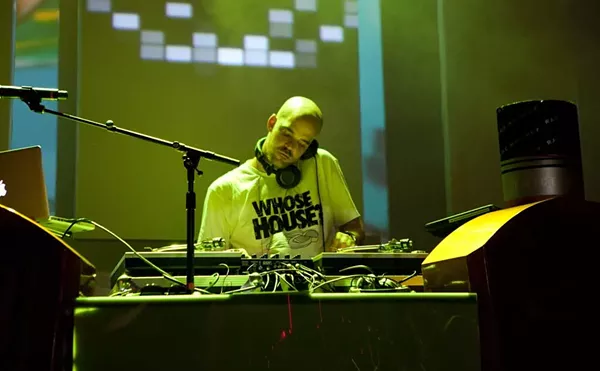“Ghandi” by Michael Betzold,
Jan. 20, 1983
An important tone-setter of MT’s early years, Michael Betzold brought a passionate commitment to his writing, whether the subject was movies, baseball, the fight to save Tiger Stadium or political organizing for a better life. His critique of the film Ghandi shows how relevant an alternative press can be to the struggles of those “who live in the belly of the most violent beast on earth.” Betzold’s wasn’t a formalist aesthetic reading of the film; he was more interested in the revelatory portrayal of Ghandi himself, the fact that “he was a fighter, not a lay-down-and-walk-over-me type.”
“Mex-town: On the verge” by Michelle Belaskie,
Feb. 1, 1984
As part of a series of questioning articles in the wake of Hudson’s downtown closure, we looked at Mexicantown and discussed its potential as a thriving commercial area. The consensus from business owners and community members at the time was, yes, even without backing from the city, it’s on its way up (and also despite rumors at the time of a Chi-Chi’s outlet opening near Clark Park). There’s still no pedestrian footbridge linking Bagley over the freeway, but Mexicantown has now become synonymous with food, fun and late-night nacho binges.
“Rock & Roll Comic Book” by Bill Rowe,
Feb. 22, 1984
Yeah, we still love Creem, “America’s Only Rock and Roll Magazine,” after all’s said and done. Bill Rowe’s ’84 dissection of Detroit’s seminal rock rag, its faults and felicities, was right on the money — like looking into a crystal ball and seeing Creem as a model for rock journalism to come, particularly the tension between serious rock criticism and advertorial selling out. Pick up one of today’s more commercial tabloids that says good stuff about everybody and ask yourself, “What’s wrong with this picture?” Rowe already knew back then.
“Scratch ’n’ Dance: A deejay could save your life tonight”
by Bruce Britt, Sept. 5, 1984
More prescience in MT’s pages with this in-person take on deejay Jeff Mills (who had just gotten his first full-time gig a few months earlier — that’s right, the year was 1984!) in an overview of the Motor City dance club scene. Among other unenlightened celebs quoted in the piece was promoter Vince Bannon: “I don’t necessarily believe in this ‘deejay as artist’ thing.” But Bannon ends the piece with some fateful fortunetelling: “Eventually the kids here will come up with something innovative. Just give ’em time.”
“Posing for Playboy” by Laura Markham,
July 7, 1985
When Playboy magazine ran an ad in the Detroit Free Press asking local women to try out for a chance to appear in its 30th anniversary issue (and receive $30,000 to do so), the auditions got everyone buzzing — even the MT staff. In the name of investigative journalism, writer and self-declared feminist Laura Markham shaved her legs, donned a bikini and tried out. She found that it was hard to pose in the right way — and hard not to compare herself with the perfect-looking women who were also willing to exploit themselves in the name of possible fame.
“Into the boards with Joe Kocur”
by Jerome Przybylski, Nov. 12, 1986
If any MT writer could (or should) take on a scrappy young Red Wing like No. 26, Joe Kocur, it would have to be Jerome Przybylski. Back in 1986, when Kocur was only into his second year in the NHL, our indomitable writer got into a fistfight in the name of getting into the spirit of the story. Comparing Kocur to Herman Melville’s handsome and brawny sailor character, Billy Budd, Przybylski gets to the heart of one of hockey’s longtime notables, well before his star really rose.
“Nothing But A (Dance) Party”
by D.L. Sherman, April 15, 1987
Hey, dancing is fun! Dancing is a popular thing to do! Those DJs and that techno music is getting to be a really big deal! Never mind that everyone knows this, now. Admit it, in 1987, the idea of replacing live music with DJs spinning records was a little bit wild. But the MT explained best why dance clubs would take off: “What some people are calling ‘just another trend’ is, in fact, dictated by undeniable economic factors that boil down to one word: profit.”
“Elvis Mitchell (The Sequel)”
by Julie Hinds, April 29, 1987
Julie Hinds cornered Highland Park homie and current New York Times film writer Elvis Mitchell when he was just starting to make waves and churn Hollywood stomach acid as the Detroit Free Press movie critic. With a heap of wit and tons of savvy, Hinds captured Mitchell’s sly, uncompromising approach to the products of the silver screen, the same attitude that made the Freep can him pretty quickly, if we remember correctly. Well, their loss is the USA’s gain, ’cause isn’t Elvis like the King of the movie mavens?
“Construction to begin immediately on Gambling World Theme Park”
by John Grant, May 27, 1987
Nothin’ like a little fun with the ol’ political football. In this satire, writer John Grant announced a new theme park, to be built on Belle Isle, which would both celebrate gambling and, to keep the churches happy, have it technically remain illegal. The plan would include games that you could put money in until it was gone, thrill rides such as the Devil’s Dive and the Tunnel of Love, Marriage and Divorce, as well as a hotel with no actual beds because, well, people at casinos rarely sleep in them anyway.
“Miracle in Detroit” by Michael Moore,
Sept. 30, 1987
When Pope John Paul II visited Detroit, more specifically Hamtramck, there was supposed to be a big commotion. Not according to Michael Moore, who detailed for MT readers the non-ruckus surrounding the visit: “There were many miracles attributed to the presence of His Holiness during that weekend in Detroit,” he wrote. “A horse named John Paul won at the Detroit Race Course.”
“A Climate of Repression” by Rosanne Less,
May 3, 1989
Beyond the group of fundamentalist Christian parents that wanted to ban the Metro Times from being used as a classroom resource at Plymouth-Canton High School, this story took a careful look at censorship and how it played out on a local level. As for the group’s objection to the MT? Nothing to do with its editorial content. They didn’t like the romance ads at the back of the paper. Hell, it was 1989. They hadn’t seen nothin’ yet.
“Stumbling into the electric century” by Monte Paulsen,
Dec. 2, 1992
Well, you read it here first (maybe). In 1992, it was predicted that an electric car would be available by the end of the decade. Maybe GM meant by the end of a decade? Or some other decade? In any case, we printed a big story about the GM Impact, an electric concept vehicle that was supposed to go from 0 to 60 in eight seconds, weigh 2,500 lbs. and travel up to 120 miles on one charge. “GM is tight-lipped about production details, but rumors of a 20,000 car-per-year run starting in 1995 have been widely reported,” we wrote. Sure.
“Chord Changes be Damned” by Richard C. Walls,
Oct. 6, 1993
“The Puzzle of the New Man” by Richard C. Walls,
Jan. 19, 1994
Among MT’s dozens of edge-dwelling music writers through the years, Richard C. Walls stands out for the sleeves-rolled-up thoroughness with which he approaches assignments, from record reviews to cover stories. Around the office, he’s thought of as a go-to authority when it comes to jazz and new music, as well as movies and modern literature. In 1993-94, Walls produced brilliant pieces on a pair of 20th century innovators: an in-depth review of John Litweiler’s biography of Ornette Coleman and an epoch-defining story on Russian composer Dmitri Shostakovich.
“The New Urbanism” by Ted Braude, July 6, 1994
“New urbanism” has become a trendy buzzphrase in the last few years, generally indicating some mythic and idyllic blend of community, commerce and condominiums. But when the MT published this article, it was looking at co-housing, a style of community development that would allow people both privacy and community access. It’s a radical idea that’s taken root in numerous cities across the country, but — six years after the article — has yet to make headway here. With our ever-spreading suburbs, maybe it’s time to think again about this very viable option.
“Beating the Bulldozer” by Stewart Francke,
July 13, 1994
Singer-songwriter Stewart Francke, a key member of the MT team in the ’90s, laid out the political and artistic issues surrounding the controversy over Tyree Guyton’s Heidelberg Project. Published near the beginning of Mayor Archer’s first term, Francke’s story speculated about the fate of Guyton’s transformation-through-art of a Detroit neighborhood, seeing his installation of shoes, street signs, dolls, etc., as part of a long tradition of avant-garde usage of everyday objects and capturing Guyton’s determination to keep on keeping on: “If the new administration wants to come in and throw all this stuff away, I’ll just do it again and again and again.”
“Swinging Low” by Chris Handyside,
June 12, 1996
It was the mid-’90s. Political correctness was out, cigars and martinis were in. So in. Oh, so very in. Someone had to get to the bottom of this hedonistic trend, and the MT was the one to do it. Hipster passport in hand, writer Chris Handyside invaded the Cocktail Nation and declared it … “hollow kitsch,” years before anyone else had the guts to admit that the leopard- and velvet-clad lounge emperors had no leisure suits on after all.
“The Party That (Almost Wasn’t)” by Amy Yokin,
Aug. 28, 1996
Opening a new business is never an easy task, but when that business is destined to become one of the hottest nightclubs in the area, possibly the country (depending on who you ask), the karmic pressure is really on. Such was the case for the owners of Motor, who had to deal with a nasty fire and extensive water damage in the venue just days before its grand opening. The MT covered the dramatic recovery, and documented how, with only minutes to go, the place was restored and the show went on — and on, and on.
“City of Mystery” by Jerry Herron,
Oct. 29, 1997
Halloween inspired this collaboration between MT’s ace photographer Bruce Giffin and architecture writer Jerry Herron. Its moody, meditative results showed that commentary, poetry and great visuals can work together when the feeling’s right. Far from a seasonal fright piece, this walk through Detroit’s Elmwood Cemetery evoked a nostalgia for the history of these downtown groves of timeless repose: “The faces of angels bowed in grief, the inscriptions on the stones themselves, are softened by the care each passing season spends here, perpetually.”
“Dear Lauryn” by Khary Kimani Turner,
Feb. 17, 1999
Necessity makes for invention, as Khary Kimani Turner proved with this open letter to Lauryn Hill just last year. Though he couldn’t get the one-on-one interview he wanted from the hip-hop diva, Turner used rejection as fuel for a beautiful examination of fame and fortune in the pop universe, from such poetic riffs as “You’re a poster child for the ‘good woman,’ the strong sista in every man’s dreams” to sympathetic realizations of the downside of celebrity: “That must feel like being fondled on a street full of strangers.” Aiight!
“Hastings Street Breakdown” by Keith A. Owens,
July 26, 2000
Keith A. Owens’ two-part history of Detroit blues was just the latest in MT’s ongoing chronicle of our fair and funky city’s illustrious musical past. It was preceded by Herb Boyd’s three-part history of Detroit jazz, Hobey Echlin’s history of Detroit techno and Ben Edmonds’ story of Motor City rock. And way back in MT’s first year of existence, Jan Loveland wrote a seminal piece called “Detroit Folk Revival,” which kind of got the whole idea rolling. Could there be more to come? Which genre’s next? Keep tuned to these pages. Alisa Gordaneer is MT features editor. E-mail [email protected]






